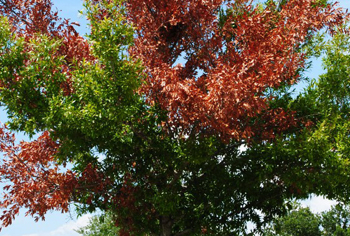 Diplodia corticola is an aggressive disease that limits the ability of oak trees to access essential nutrients and water, ultimately killing them.
Diplodia corticola is an aggressive disease that limits the ability of oak trees to access essential nutrients and water, ultimately killing them.
It was first reported in Europe, and has since emerged in Florida, California, Massachusetts and Maine. This is the first time that it’s been found in oak trees in West Virginia.
Infection in live oak trees (Quercus virginiana) infected by D. corticola in California and Florida may be more difficult to detect, since it is not preceded by cork removal. Clumps of dead branches suddenly appear in the crown, randomly distributed. Cankers (elongated cracks in the bark) are evident on branches, and cutting into the branch at these points reveals sapwood and phloem discolored to dark brown. Pycnidia, tiny black spots which contain conidia, erupt through the bark or cankers.

It is unknown how Diplodia corticola and Diplodia quercivora colonize oaks. However, members of the Botryosphaeriaceae, the family to which the genus Diplodia belongs, are generally known to enter plants through wounds, including leaf scars, or stomata open for gas exchange. They often live harmlessly as endophytes within the plant, becoming pathogenic when the plant is stressed by environmental factors such as drought, flooding, heat, freezing, herbicide use, or soil compaction (Bush, 2009; Vajna, 1986). The fungus may colonize dead tissue, then move into healthy tissue in the branch. It can be spread by air, water splash, or contaminated pruning tools. In the case of cork oak, Quercus suber, the traditional practice of removing cork from the trunks of oak trees causes mild injury, thus likely providing entry for Diplodia corticola, as evidenced by cankers on the trunk. In Florida, a trunk canker has been observed only once: the most common diagnostic features are branch cankers and twig dieback. Thus, D. corticola/D. quercivora may enter through lenticels. Their close relative Botryosphaeria obtusa is known to enter plants through lenticels and stomata.
Oaks in cultivated landscapes, unlike those in forests, are exposed to stresses such as transplanting, pruning, herbicides, and water stress brought on by extensive periods of both drought and flooding. Pruning might create the wounds that provide entry to these pathogens. Also, most of Florida experienced severe drought in 2010, the year reports of dieback began.
Since 2009, D. corticola has been reported causing cankers for the first time in five North American oak species as well as grapevines in California and Texas
D. corticola has been reported to cause cankers and dieback in several Quercus spp. in Greece, Hungary, Italy, Morocco, Portugal, and Spain and has recently been reported to cause cankers on Q. chrysolepis and Q. agrifolia in California. Inoculations of coast live oaks with D. corticola in California produced additional symptoms not seen in Florida, including epicormic shoots, leaf desiccation, and lesions on roots.
The source of D. corticola (and D. quercivora) in the United States is unresolved. The ITS ribosomal DNA sequence of the strain of D. corticola isolated in Florida (from Marion County) has 100% homology to the strains from oaks in California and Europe, as well as from Vitis vinifera in Texas. The ITS rDNA sequence of the D. quercivora strain from Alachua County, FL, has 99% homology to D. quercivora isolated in Tunisia. There are substantial indications in the literature, dating back to 1912, that D. corticola (or D. quercivora, or both) may be native to North America
Attempts to tie entry of the fungus in oaks to an insect vector in California (ambrosia beetles or the gold spotted oak borer) have been inconclusive .
Mauget Note:
Mauget ‘s effective fungicice FUNGISOL, carries a registration for Diplodia in most states in the U.S.
More Referance Readings can be found on these sites:
http://tinyurl.com/josxkhr
http://tinyurl.com/jf9pw3g
http://tinyurl.com/jj9w4aq
http://tinyurl.com/h4qyr48
There are more referances to view if you want to take the time to seek them out.

